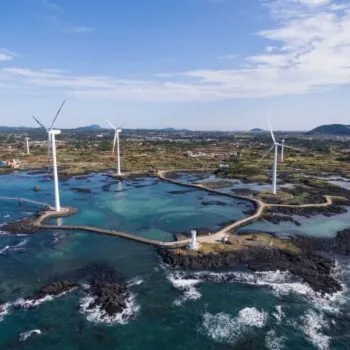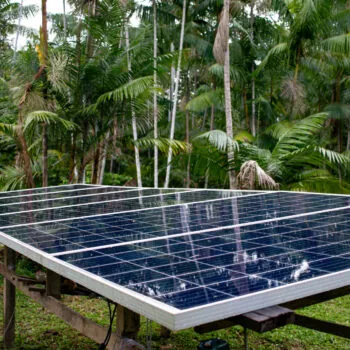In 2025, all countries are due to submit updated or new Nationally Determined Contributions (NDCs), setting out their climate plan and commitments to 2035. These NDCs are a key test of whether governments are responding to the Global Stocktake (GST-1) agreed at COP28 in Dubai, and, in particular, what domestic policy commitments they are making to deliver on the global energy transition goals set out in Paragraph 28.
This interactive tool monitors how countries’ new or enhanced NDCs reflect the energy transition outcomes agreed in Paragraph 28 of the COP28 Global Stocktake.
These outcomes include tripling global renewable energy capacity by 2030, doubling the rate of energy efficiency improvements by 2030, phasing down coal power, transitioning away from fossil fuels in energy systems, and phasing out inefficient fossil fuel subsidies.
Since November 2024, 60 countries have submitted updated or new NDCs, covering 31% of global emissions. This tracker was last updated at 09:00 BST on 02 October 2025.
Energy transition commitments are broken down further into metrics: clean energy deployment, energy efficiency targets, no new coal, phase down of unabated coal power, pathways to wind down oil and gas production, reducing fossil fuels’ share of electricity, and phasing out inefficient subsidies. The tracker also highlights where commitments are conditional on international finance or support. Hover over each metric to read the relevant language in the NDC.
To capture progress, the tracker assesses whether each NDC:
- Does not mention how the country will act on the commitment in question.
- Mentions how the country will act on the commitment, without giving a target or timeframe.
- Sets a quantified target or timeline to meet the commitment.
- Sets a quantified target or timeline to meet the commitment AND this is the highest level of ambition (either the country’s first NDC or an enhancement of a previous one).
- Or if the commitment is not applicable to that country, e.g. a country has no coal in its electricity mix (marked as cream/blank).
It also identifies whether these energy-related targets are conditional on international finance or capacity-building support – hover over the target to see conditionality and the relevant NDC quote.
Updated with each new country submission to the UNFCCC, this tracker offers a quick overview of how far NDCs are laying out concrete plans to deliver on the COP28 energy package — and where ambition needs to be raised ahead of COP30 in Belém.
The full methodology can be found here.
Key takeaways
93% of countries have included some form of policy commitment in their updated NDC to reach at least one of the energy outcomes tracked here – on tripling renewables, doubling energy efficiency, and fossil fuel phaseout.
When comparing countries’ most recent NDCs to their previous submission, 67% of countries (40/60) include a quantified target that is their highest level of ambition so far for at least one of the assessed energy goals.
While the vast majority of countries include mentions of increasing the deployment of renewable energy and improving energy efficiency, these targets are less substantiated for energy efficiency. 72% of newly submitted NDCs give a quantified target for renewables deployment, but only 48% quantify energy efficiency improvements. Many of the new climate plans (47/60) also include explicit references to displacing fossil fuels in their electricity mix. However, specific language on winding down the production of coal, oil, and fossil gas is lacking in almost all NDCs.
No countries have presented a plan to comprehensively meet the tracked energy goals. This suggests that countries are seeing the clear benefits of moving towards clean energy and towards clean power systems, but are not yet taking the necessary steps to plan for a corresponding shift away from fossil fuels in line with the GST commitment.
Click to expand and read E3G’s analysis, drawn from the NDC Energy Commitments Tracker, on how countries’ NDCs are responding to that commitments made in the response to the Global Stocktake made at COP28:
- The majority of countries include quantified targets for renewable energy deployment: almost three-quarters (72%, 43/60) of the NDCs submitted to date either quantify their 2035 renewable energy goal, or, in the case of Ethiophia, Uruguay and Lesotho, already have such a high penetration of renewables in their power mix that an increase in ambition is not possible. The Holy See and Vatican City is excluded as “the State has neither fossil fuel sources not energy production plants, with the exception of a negligible amount of energy produced from renewable sources.”
- 53 countries’ NDCs include quantified targets OR mention plans to increase renewable energy capacity without specific targets or timeframes.
- Nigeria’s NDC targets a 50% renewable energy share in the generation mix by 2030, though this includes 17,000MW of gas, a non-renewable fossil fuel.
- Seven countries – Bolivia, Honduras, Japan, Mongolia, Norway, Serbia and Zambia – do not mention increasing renewable energy deployment at all in their NDCs. Norway directs readers to their National Inventory Document (NID), submitted in March 2025, which states that: “Norway produces electricity mainly from hydropower and therefore, emissions from electricity production are small compared to most other countries.”
- Almost all countries – 90% (54/60) – mention improving energy efficiency in their NDC. However, only 29 (just under half) provide a quantified target; the remaining 25 NDCs that mention energy efficiency reference making improvements without providing any detail.
- Energy efficiency references feature on both the supply and demand side.
- Of the 29 countries that provide a quantified target for their energy efficiency goals, 25 explicitly reference appliance efficiency and other demand-side measures (37% of all newly submitted NDCs): Andorra, Angola, Barbados, Bangladesh, Belize, Bolivia, Cambodia, Cuba, Lesotho, Liberia, the Marshall Islands, Mauritius, Micronesia, Moldova, Nepal, Nigeria, Pakistan, Sao Tome and Principe, the Solomon Islands, Somalia, Sri Lanka, Tuvalu, the UAE, the UK, and Vanuatu. This matches earlier analysis from CLASP, which celebrates the higher rate of countries including appliance efficiency in their NDCs in this submission cycle, but states that actionable targets are still needed to maximise impact.
- Eleven countries explicitly refer to improving supply-side efficiency, such as modernising the grid and reducing transmission or generation losses (16% of all newly submitted NDCs): Belize, Cambodia, the Marshall Islands, Micronesia, Nepal, Nigeria, Sao Tome and Principe, Sri Lanka, Tuvalu, the UAE, Zimbabwe.
- 78% of countries that have submitted new NDCs (47/60 countries) either have no coal in their energy mix, or reference intentions to phase down unabated coal power.
- Of the countries still using coal, over half (58%, 18/31) mention plans to phase down unabated coal power, with nine countries providing a timeline for this effort. Nine countries (29% of those with coal, 9/31) include a commitment to stop permitting and building new coal. These are Australia, Cambodia, Canada, Colombia, Mauritius, Morocco, Singapore, Sri Lanka and the UK.
- Just under half of the countries that have submitted NDCs so far (29/60) do not have coal-fired power plants.
- Only three countries who have set quantified targets to phase down coal, Australia, Cambodia and Nepal, are not members of the Powering Past Coal Alliance:
- Cambodia is targeting a 72% renewable energy share by 2035 and commits “to gradually reduce reliance on coal-fired power plants while ensuring energy security during the transition to renewable energy.” This includes implementing a coal moratorium on new projects and accelerating the retirement of older inefficient plants.
- “Australia is rapidly shifting to a modern, cost-effective electricity system based on renewable energy, with coal-fired power-generation phasing out […] Modelling by the Australian Energy Market Operator indicates that under a net zero scenario, 90% of today’s coal capacity could be closed by 2035, and the entire coal fleet before 2040.”
- Nepal has set quantified targets to reduce the percentage share of coal used in industry and heating.
- There are seven PPCA members that have coal in their electricity mix, but have not included a quantified target or timeline to phase down its use in their power sector coal in their new NDCs: Colombia, Montenegro, New Zealand, Norway, Switzerland, UAE, USA.
- 44 NDCs (77%) mention some form of intent to transition away from fossil fuels in the power mix overall(across coal, oil and gas); 34 of these are quantified targets or timelines. [N.B. Uruguay and Lesotho are excluded from this analysis as they already have a high penetration of renewables in their electricity mix. The Holy See is also excluded as “the State has neither fossil fuel sources nor energy production plants, with the exception of a negligible amount of energy produced from renewable sources.” The 77% figure is calculated as 44/57 NDCs.]
- Examples include Kenya’s updated NDC, in which the government pledge to “Undertake energy sector reforms aimed at universal access to adequate, reliable, and affordable energy services, to enable the achievement of […] increased renewable electricity generation in the national grid towards 100% by 2035”. This target is conditional on international support.
- Vanuatu includes the strongest language on fossil fuel phase out, writing: “This NDC recommits Vanuatu to rapidly phasing out fossil fuels, deeply decarbonising and transitioning completely to a circular economy. […] This NDC 3.0 maintains Vanuatu’s position to become a Fossil Fuel Free Pacific, the first region in the world to achieve the equitable phaseout of fossil fuel production and use.” Vanuatu’s NDC is conditional on internal finance and support.
- Brazil’s NDC mentions the need for launching international work to define equitable timelines to transition away from fossil fuels “with developed countries taking the lead.”
- No country has provided a quantified target for winding down oil and gas production. Of the 60 countries that have submitted NDCs in this cycle, 30 produce oil or fossil gas.
- Of these 30, only three – Canada, Colombia and the United Kingdom (UK) – included a mention of reducing oil and gas production:
- Canada: “New and additional actions may be considered as part of the development of Canada’s 2035 Emissions Reduction Plan. [This includes] Transitioning away from fossil fuels in energy systems in a just, orderly and equitable manner”. The UK notes: “We will consult on not issuing new oil and gas licenses to explore new fields.”
- Colombia: “The country has taken historic decisions, including the suspension of new hydrocarbon exploration contracts, while moving forward with plans for a progressive reduction in the use of fossil fuels.”
- The UK is targeting at least 95% of power generation being from renewable sources by 2030, and phased out coal in 2024.
- 44 countries target a reduction in domestic fossil fuel consumptionthrough references to lowering fossil fuels’ share of the electricity mix – this is 77% of the NDCs from countries where renewables constitute less than 95% of the electricity mix. Of these 44 countries, 34 (60%) provide a quantified target or timeline for doing so.
- NDCs also reflect more broadly how countries are considering their transitions away from fossil fuels. A small but growing set of NDCs explicitly reference economic transition alongside energy targets. For example, Barbados acknowledges the fiscal risks of shifting away from imported fossil fuels; the UAE links its climate goals to long-term economic diversification beyond oil and cites the COP28 call to “transition away from fossil fuels”; and Canada and the UK highlight worker re-skilling and jobs legislation as part of managed economic transitions. Others, including Moldova and the Maldives, reference economic diversification plans, though these are not yet the same as a comprehensive transition strategy to reduce dependence on oil and gas.
- Very few countries reference fossil fuel subsidies. Of the 60 countries that have submitted updated or new NDCs in this cycle, 40 (67%) have not mentioned fossil fuel subsidy reform, despite its inclusion in Paragraph 28.
- Fifteen countries (25%) mention fossil fuel subsidies, but do not include a timeline for their phase out: Angola, Australia, Canada, Chile, Colombia, Lebanon, Liechtenstein, the Maldives, the Marshall Islands, Moldova, Switzerland, the UAE, the UK, Uruguay, and Vanuatu. No country includes a timeline for the phase out of fossil fuel subsidies.
- While they do not provide a quantified goal or timeline for phasing out inefficient fossil fuel subsidies, five countries (10% of new NDCs) either mention the intention to provide this or are members of a coalition committed to implementing national strategies for exiting these subsidies: Australia, Canada, the Marshall Islands, the UK, and Vanuatu.
- The Marshall Islands and Vanuatu include the strongest language on fossil fuel subsidy exit, with both SIDS stating that they are committed to phasing out all fossil fuel subsidies “as soon as possible”.
- Five countries do not have inefficient fossil fuel subsidies: Holy See, Monaco, Singapore, Somalia and Tuvalu.
- Just over two-thirds (68%, 41/60) of the 2035 NDCs – and of EMDEs, 87% of the 2035 NDCs – submitted to date are conditional (or partly conditional) on international finance, technical assistance, or some other form of support.
- Zimbabwe and the small island developing states of Barbados and Niue are outliers in submitting a conditional NDC that has lowered ambition on an energy goal, signalling that the necessary finance to support energy their energy commitments is not flowing.
- Barbados revised its previous goal of achieving a fossil fuel-free economy by 2030 to 2040, “in light of the significant challenges faced by the country”.
- Niue’s previous NDC targeted an 80% share of renewable energy in the electricity mix by 2025; in its new NDC, this target has been pushed to 2035.
- Zimbabwe delayed its target of 300MW of grid-connected solar from 2025 (as outlined in its previous NDC) to 2035. The expansion of microgrids to 2MW is also delayed from 2028 to 2035.


